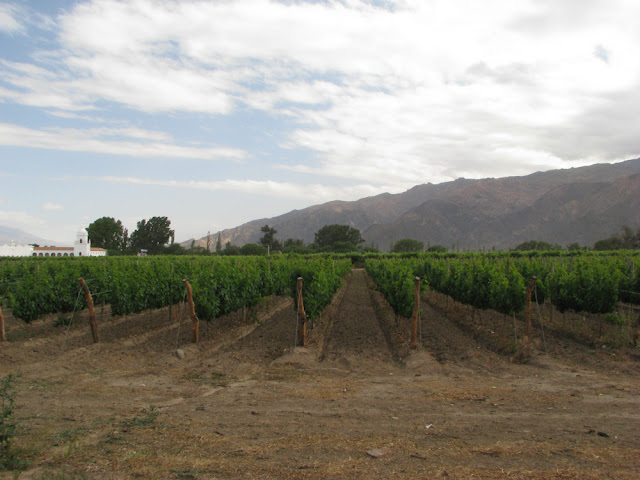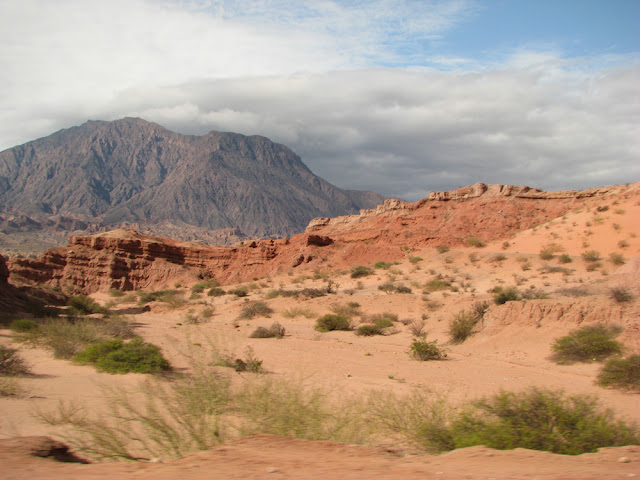(If you're just coming to the blog and want to read from the beginning of the trip, start here.)
Day 3: Monteros to Salta (via Tafi del Valle and Cafayate)
Distance: 390 kilometers
Today's drive was one of the most beautiful I've ever done — from thick wooded forests to vineyards surrounded by mountains, to deep red canyons.
We woke up in Monteros after a night of rain, and headed for Cafayate (ideally this was to be our lunch spot). Along the way I learned a new Spanish word — "desvio." It quickly became my least favorite Spanish word. We'd been warned that the road west would be slow-going, but we weren't expecting the frequent "desvios" (or detours) that took us off the paved road onto bumpy dirt and gravel, which our bike wasn't meant to handle. Add to that the sharp blind curves, and the fact that we had to ascend 1,300 meters (4,500 feet), and it took us about 2.5 hours to go 80 kilometers.
 |
| The most dangerous part of this leg was the tour buses careening down the blind gravel curves |
But it was well worth it once we neared Tafi del Valle. We had been surrounded by thick vegetation throughout our ride, but that all cleared as we reached the village. The dark forest green trees of earlier were replaced by grass the shade of an avocado. Goats roamed high up on the hills and the landscape extended outward on all sides.
But we couldn't stop, we had too much ground to cover. The road climbed even higher, and now we were enveloped in total fog. We could see maybe 50 feet in front of us, but luckily not that many people traverse this particular mountain road. We rode on, finally descending, and as the fog cleared, we discovered the landscape had completely changed. Now we saw cacti and shrubs. No goats, no hills. A fertile valley had turned into a desert in just a couple dozen kilometers. Ben likened the landscape to the West Bank.
We continued on, and soon reached one of my favorite parts of the trip, the Valles Calchaquies. If there's one regret I have about our trip, it's that we didn't get to spend more time here. This part of the valley is home to the wine-growing region of Cafayate, known for the white Torrontes grape. The rows of vines are flanked on either side by the deep red hues of the Andes. We'd see many more stunning mountain landscapes over the trip, but it was the contrast of colors — between the vines and the mountains — that I found so breathtaking here.
By 3 p.m., we reached Cafayate, and found a delightful restaurant that served us bread with gazpacho for dipping and big, juicy steaks. Ben said the town reminded him of New Mexico (plus the wine). And for the first time on our trip, it was obvious that we were in a place that catered to luxury. We had traveled about 1,500 kilometers on a motorcycle to get here, through rain and wind, and slept in a tent and in a motel. But you can just as easily arrive in Cafayate by flying to the regional capital of Salta two hours north, and hiring a tour company or a hotel car service to drive you here. We passed a hotel/spa on our way into town. As we ate, a British man asked us what we were eating so that he could point at it to the waiter to tell him he wanted the same. A different way to travel, for another trip.
Once we headed out, the landscape changed once again. Huge rock formations rose on either side of us. The Windows, the Castles, the Frog, the Friar. Even better was the road. Straight roads are boring, I'd discovered on day 1. Sharp turns are slow, I'd discovered this morning. But these were curves you could lean into as the bike hugged the canyon walls. And every time you turned, there was something new to see.
Unfortunately, it started to rain once we exited the canyon, still 100 kilometers from Salta. About two hours later, we finally reached our hotel, soaking wet, and fell into bed.
Watch a short video of our drive through the canyon. The most interesting part starts halfway through. (The audio is wind mixed with Counting Crows.)
- Steph















It looks like you went through istockphoto.com and invented a trip. Particularly that steak..... hmm
ReplyDelete